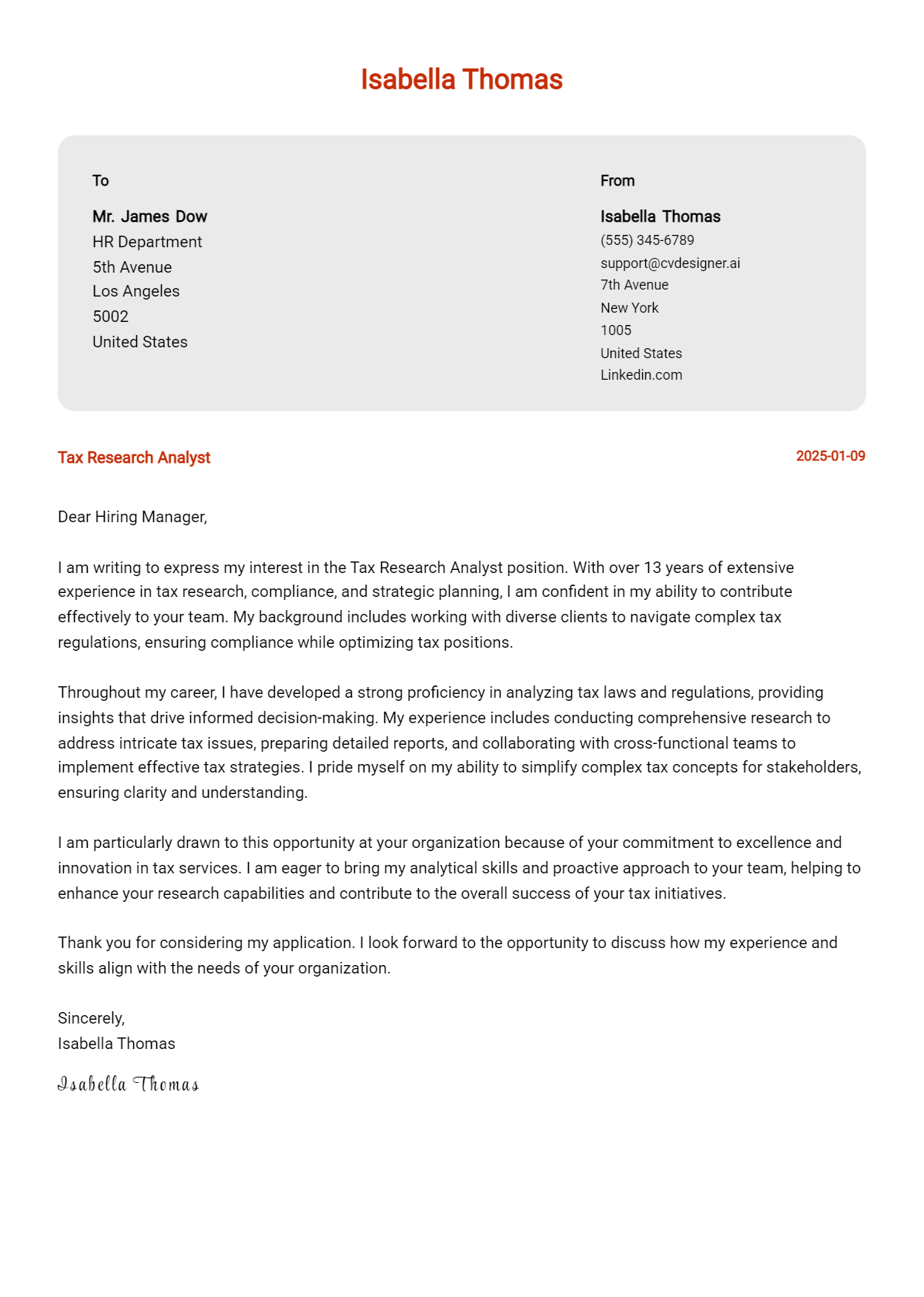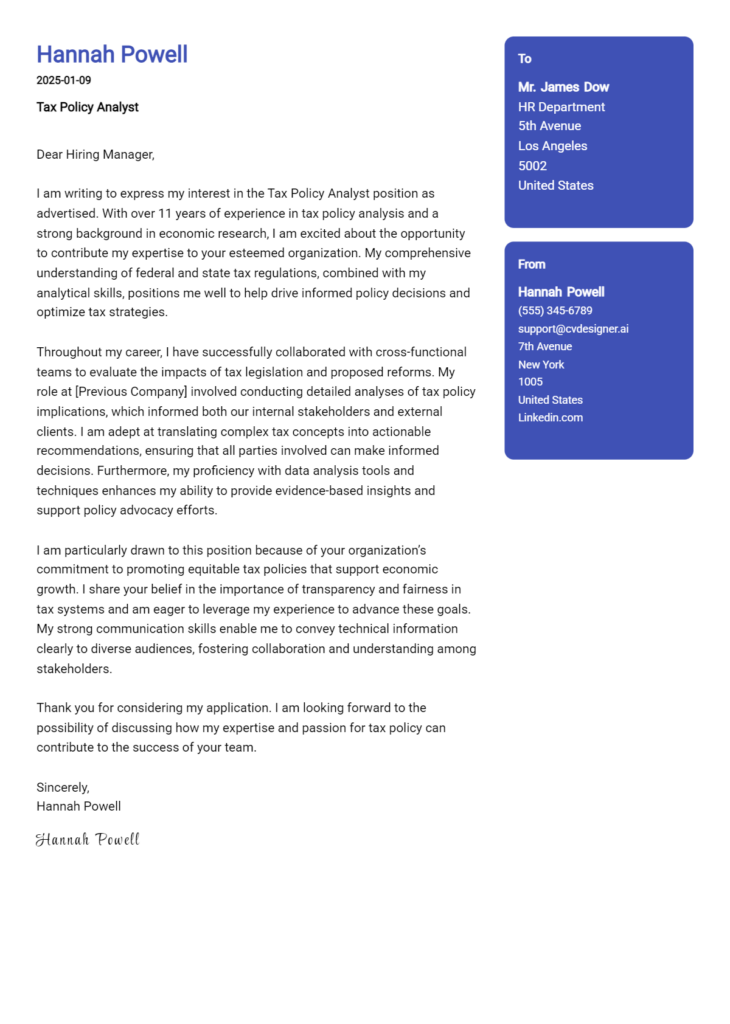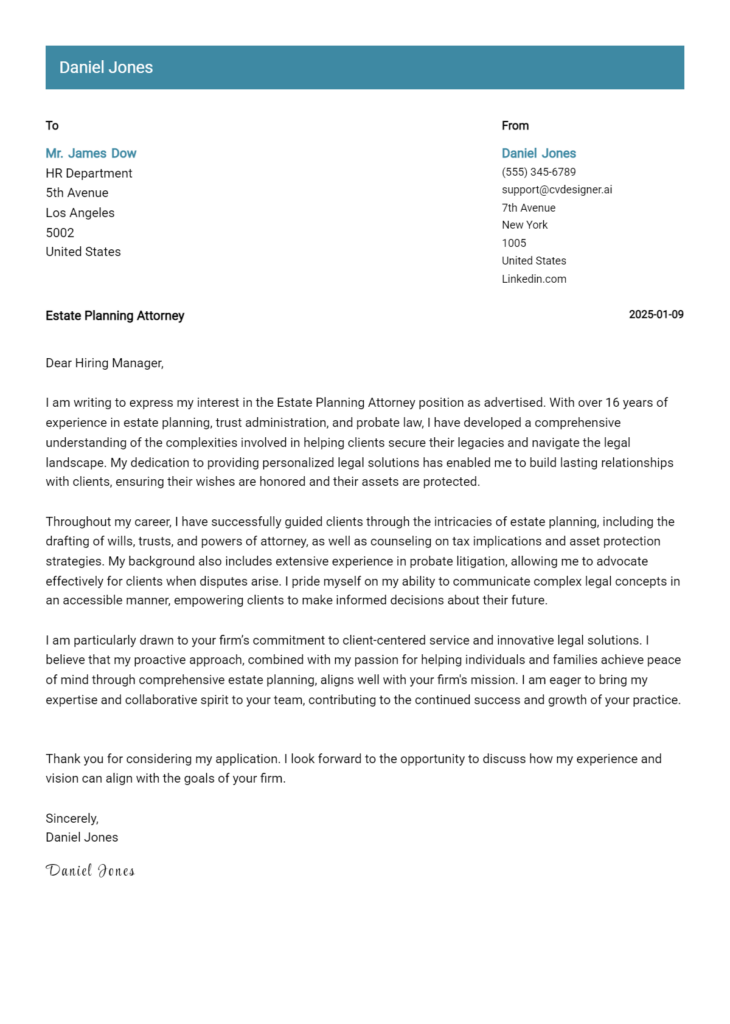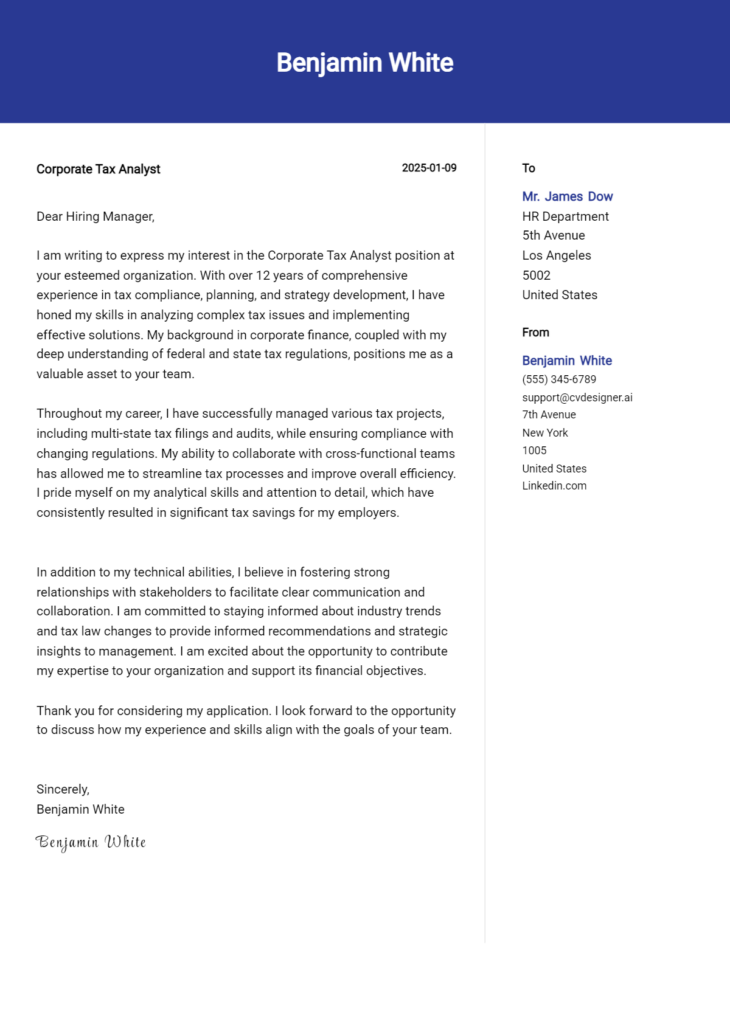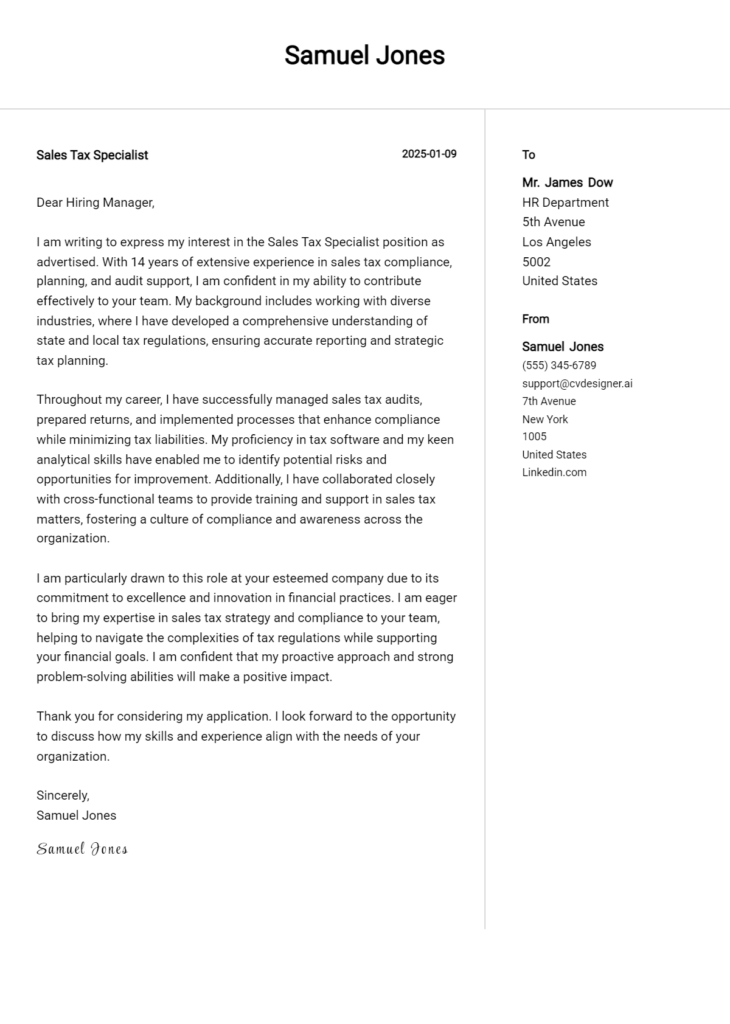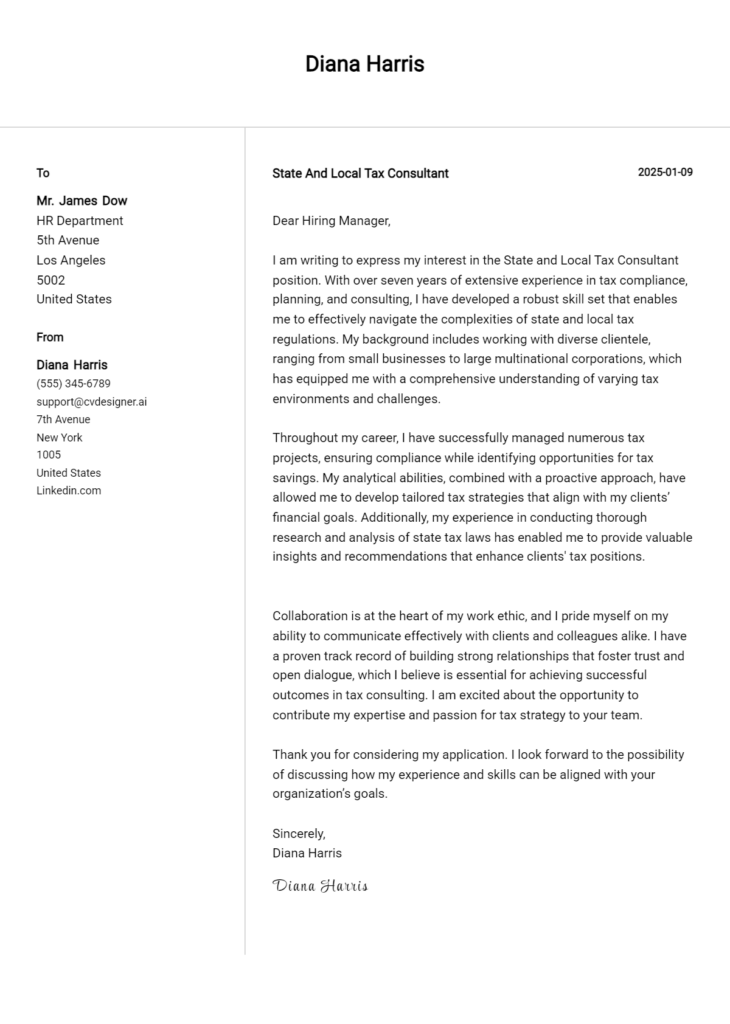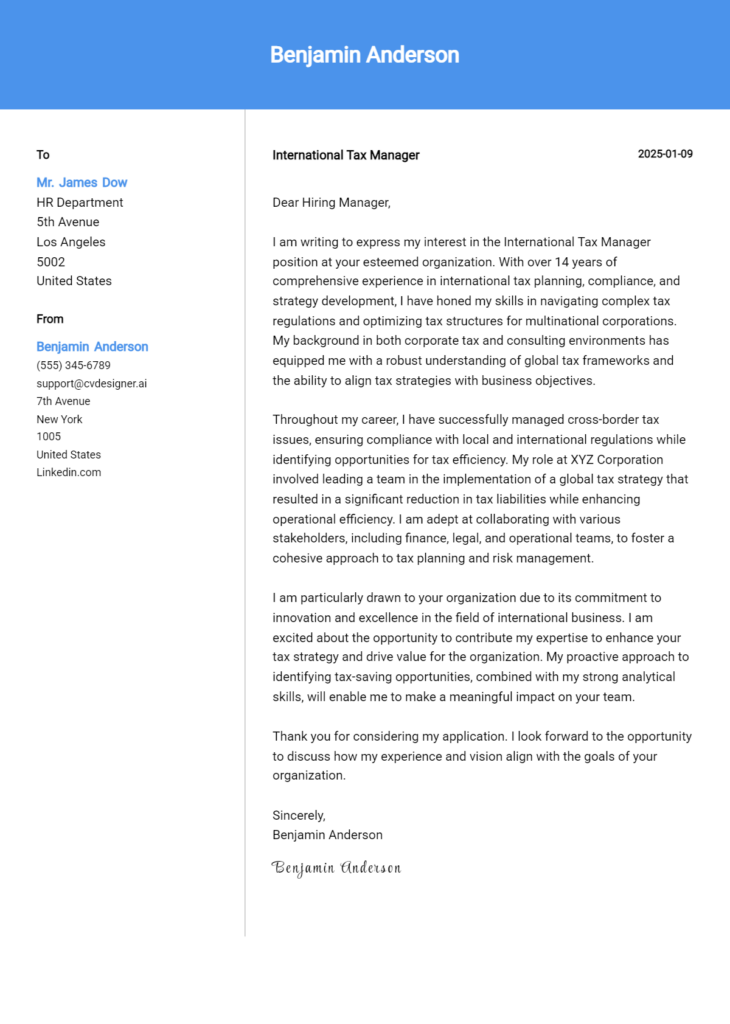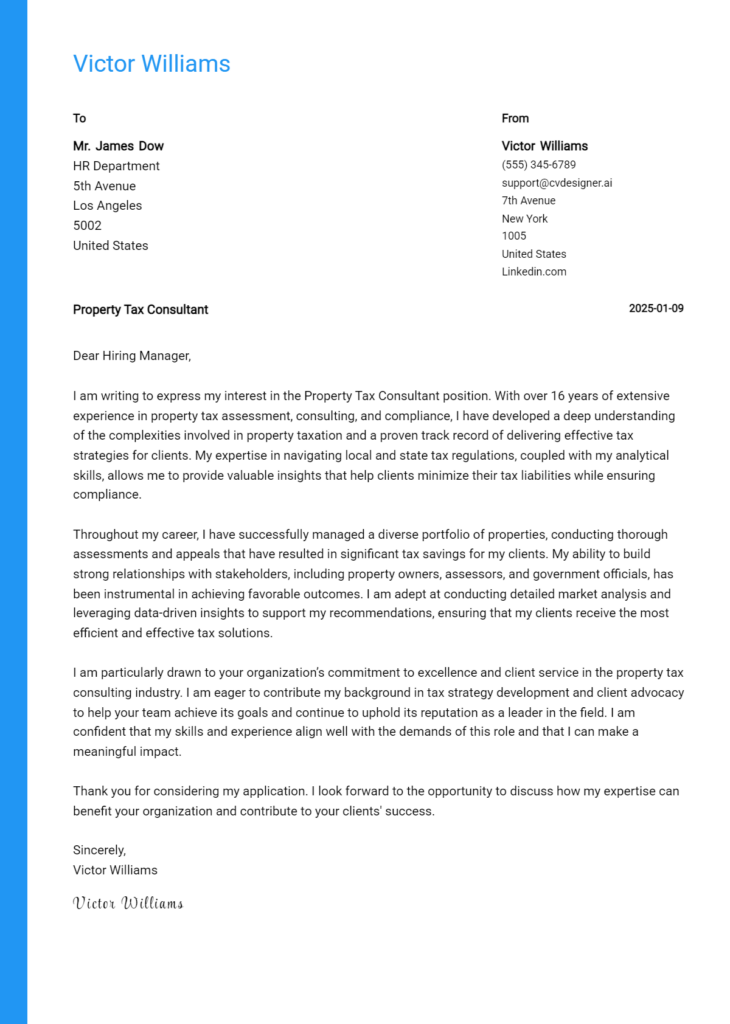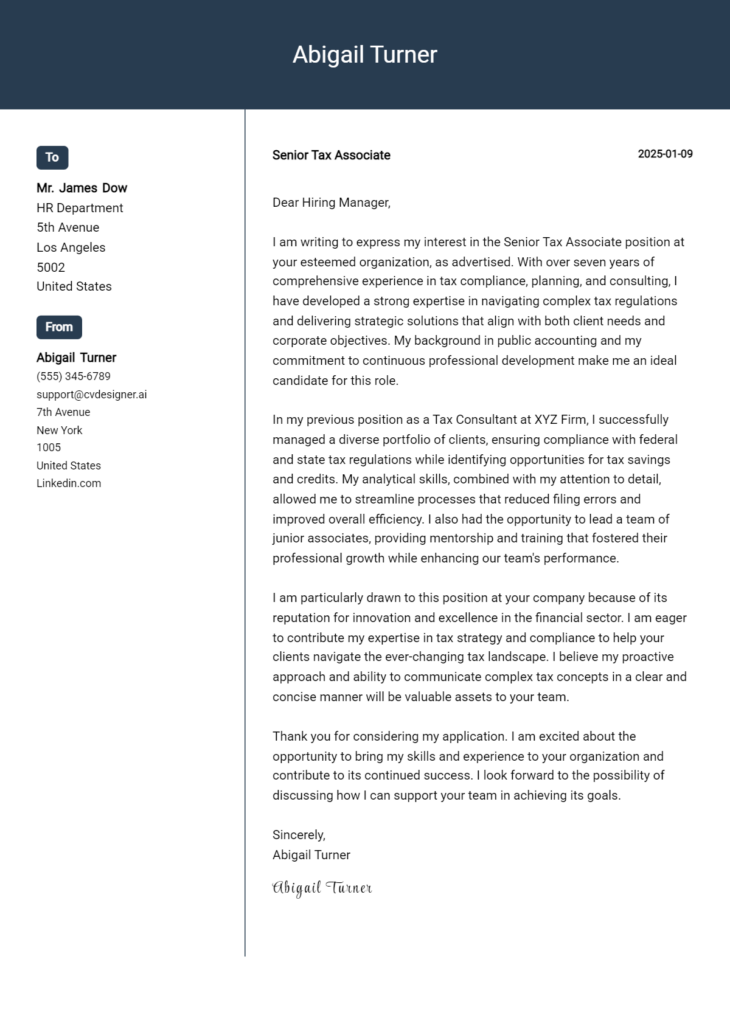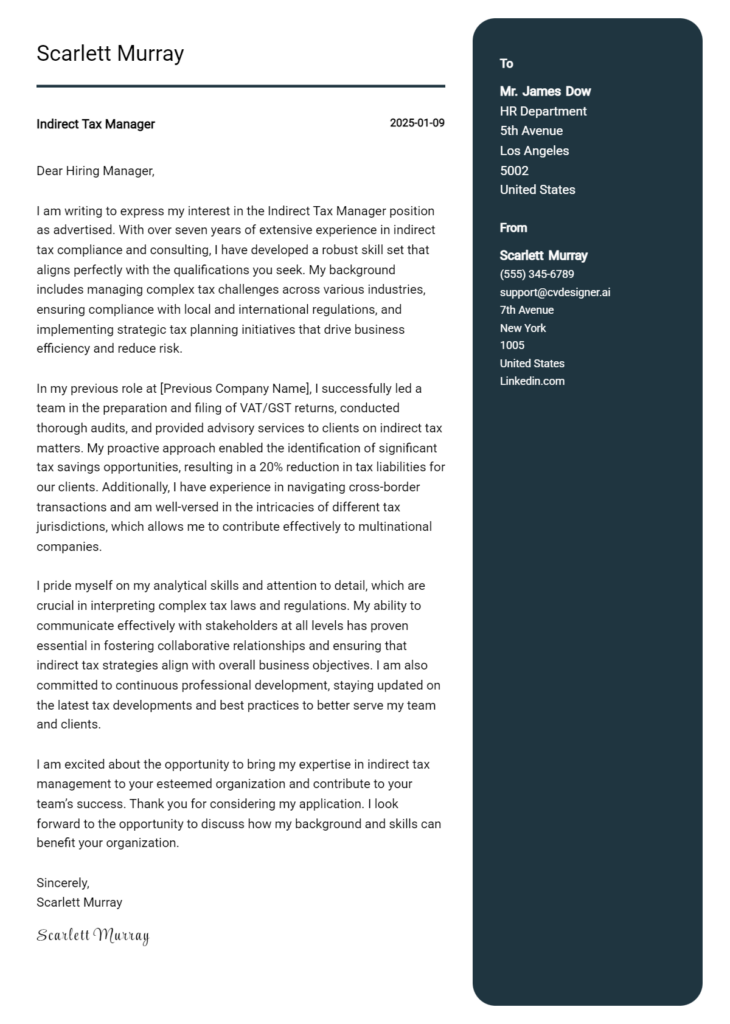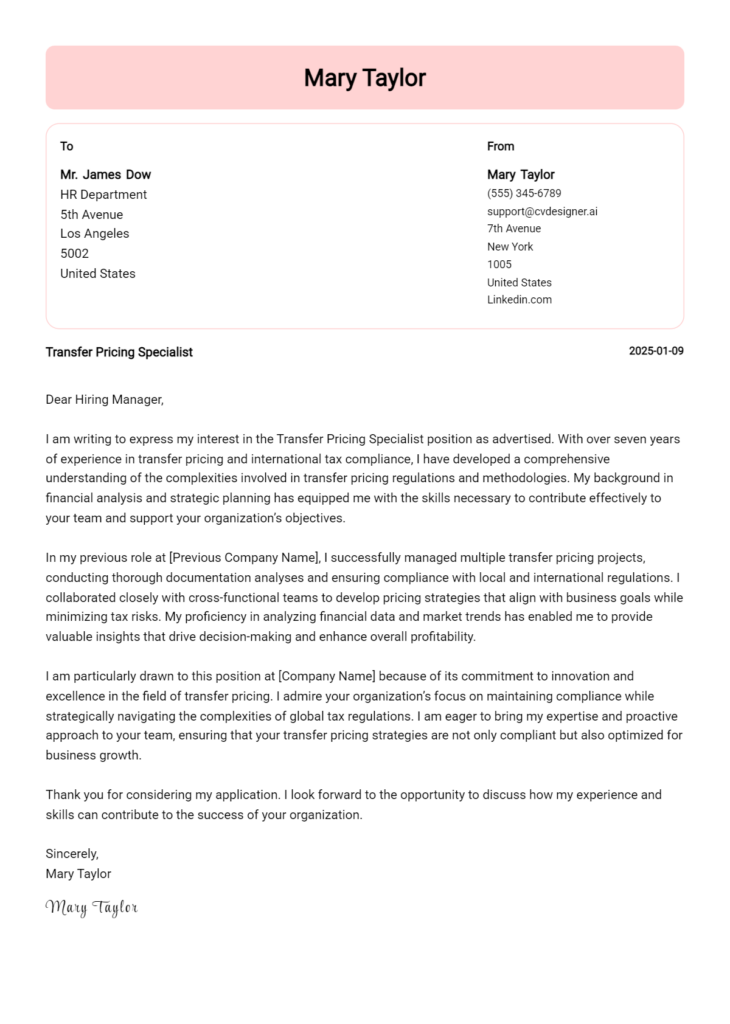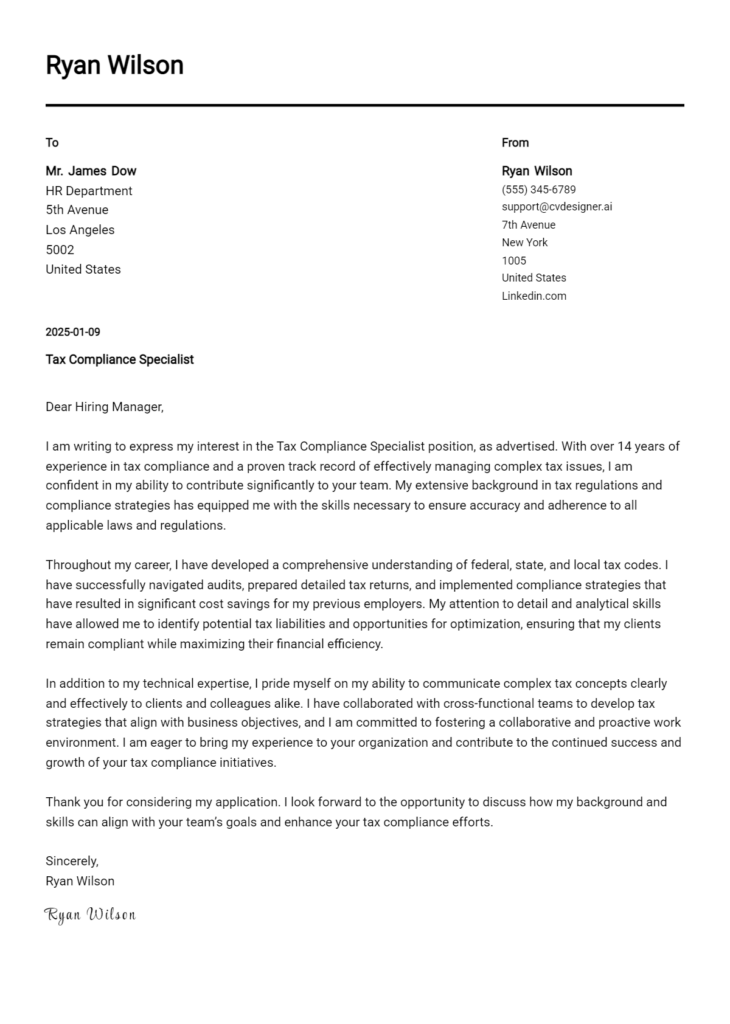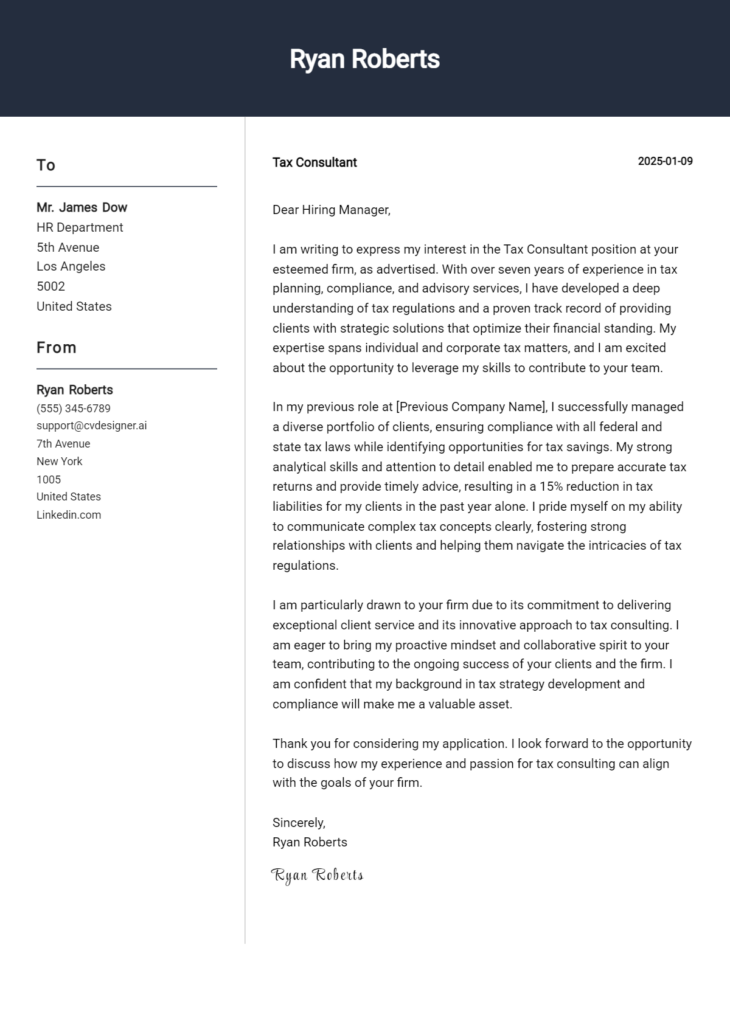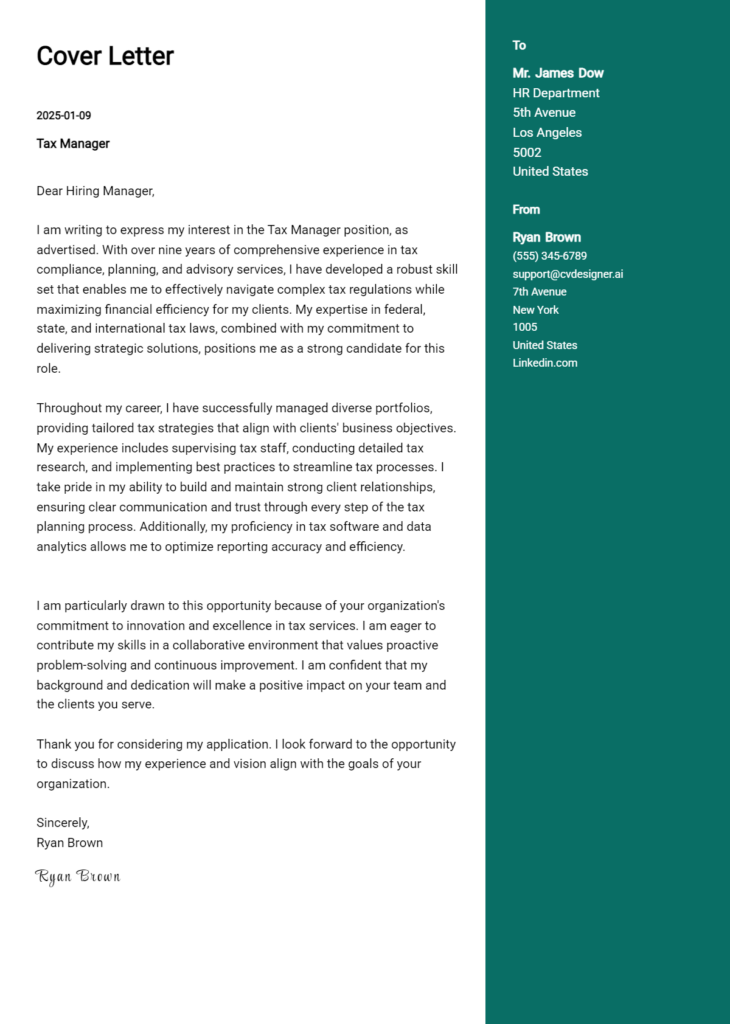Tax Research Analyst Cover Letter Examples
Explore additional Tax Research Analyst cover letter samples and guides and see what works for your level of experience or role.
How to Format a Tax Research Analyst Cover Letter?
Crafting a well-formatted cover letter is essential for a Tax Research Analyst, as it not only conveys your qualifications but also demonstrates your analytical skills and meticulous attention to detail. In a profession where precision is paramount, the structure of your cover letter serves as a reflection of your professional capabilities. A thoughtfully organized document can effectively capture the hiring manager's interest while showcasing your expertise in tax regulations and research methodologies, both of which are crucial for the role.
In this guide, we will outline how to structure your cover letter, providing insights and examples tailored for tax research analysts.
We will focus on the essential components of a professional cover letter, including:
- Cover Letter Header
- Cover Letter Greeting
- Cover Letter Introduction
- Cover Letter Body
- Cover Letter Closing
Each section plays a crucial part in presenting your qualifications and professionalism. Let’s break down each part and discuss how to make your Tax Research Analyst cover letter stand out.
Importance of the Cover Letter Header for a Tax Research Analyst
The cover letter header is a crucial component of any job application, particularly for a Tax Research Analyst position where attention to detail and professionalism are essential. The header provides the first impression to potential employers and sets the tone for the rest of the application. It should include your contact information, the date, and the recipient's details, all presented clearly and concisely. A well-formatted header ensures that your application is organized, making it easy for hiring managers to find the necessary information quickly. This clarity reflects your ability to organize complex information—an important skill for a Tax Research Analyst.
Strong Example:
Jane Doe 1234 Maple Street Cityville, ST 12345 (123) 456-7890 jane.doe@email.com October 1, 2023 Mr. John Smith Hiring Manager XYZ Tax Solutions 5678 Oak Avenue Townsville, ST 67890
Weak Example:
jane doee cityville, st (123) 456-7890 October 1, 2023 xyz tax solutions
The Importance of the Cover Letter Greeting
The greeting of a cover letter serves as the first impression a hiring manager will have of you as a candidate. It sets the tone for the rest of the letter and can significantly impact how your application is received. A well-crafted greeting demonstrates professionalism and personal touch by addressing the hiring manager directly, which can help you stand out in a competitive job market. Avoiding generic greetings like "To Whom It May Concern" showcases your initiative and attention to detail, while researching the recipient's name adds a layer of personalization that can resonate positively with the reader. In your pursuit of a Tax Research Analyst role, taking the time to find the appropriate name not only reflects your commitment to the position but also your genuine interest in the organization.
Strong Greeting Example
Dear Ms. Jane Smith,
Weak Greeting Example
To Whom It May Concern,
The Importance of a Strong Cover Letter Introduction for a Tax Research Analyst
A well-crafted cover letter introduction is crucial for a Tax Research Analyst position as it serves as the first impression to the hiring manager. This opening paragraph should not only capture their attention but also express the candidate’s genuine interest in the role. Furthermore, it should briefly showcase key skills or achievements that align with the job requirements, setting the tone for the rest of the letter. A strong introduction can differentiate a candidate from others and create a compelling case for further consideration, while a weak introduction may fail to engage the reader, resulting in missed opportunities.
Strong Example
Dear [Hiring Manager's Name], As a dedicated Tax Research Analyst with over five years of experience in tax compliance and analysis, I was thrilled to discover the opening at [Company Name]. My extensive background in interpreting complex tax regulations and successfully implementing strategic solutions has not only reduced liabilities for my previous employers but has also ignited my passion for helping organizations navigate the intricacies of the tax system. I am eager to bring my analytical skills and attention to detail to your esteemed team and contribute to [Company Name]'s commitment to excellence in tax research.
Weak Example
To Whom It May Concern, I am applying for the Tax Research Analyst position because I need a job. I have some experience with taxes and I think I could do the work. I am looking forward to hearing from you.
Purpose of the Cover Letter Body for a Tax Research Analyst
The cover letter body for a Tax Research Analyst serves as a critical platform for candidates to articulate their relevant skills, experiences, and the unique value they can bring to the organization. This section allows candidates to highlight specific projects or accomplishments that demonstrate their expertise in tax regulations, research methodologies, and analytical skills. By detailing how their previous work has led to successful outcomes—such as identifying tax savings, improving compliance processes, or contributing to impactful research studies—candidates can effectively position themselves as strong contenders for the role.
Strong Example
In my previous role at XYZ Corporation, I led a project that resulted in a 15% reduction in our overall tax liability through meticulous research and analysis of state tax credits. By collaborating with cross-functional teams, I developed a comprehensive tax strategy that not only ensured compliance but also maximized savings. Additionally, I authored a detailed report on recent changes in tax legislation, which was subsequently utilized by our finance department to inform strategic decision-making. My ability to translate complex tax concepts into actionable insights has consistently contributed to enhancing operational efficiency and achieving financial goals.
Weak Example
I have worked in tax research for a couple of years and have some experience with tax regulations. I believe I can do the job well because I pay attention to detail. In my last job, I helped with a project, but I am not sure how much it saved the company. I also read about tax laws occasionally. I think I would be a good fit for your team because I am passionate about tax research.
The Importance of the Cover Letter Closing for a Tax Research Analyst
The closing paragraph of a cover letter is crucial as it encapsulates your qualifications, reiterates your enthusiasm for the Tax Research Analyst position, and encourages the hiring manager to take the next steps, such as reviewing your resume or scheduling an interview. A strong closing leaves a lasting impression and reinforces your suitability for the role, while a weak closing may fail to convey your passion and commitment, potentially leaving the reader with doubts about your candidacy.
Strong Example
Thank you for considering my application for the Tax Research Analyst position. With my extensive background in tax law research and my proven analytical skills, I am confident that I would be a valuable asset to your team. I am eager to contribute to your organization and further discuss how my qualifications align with your needs. I look forward to the opportunity to speak with you soon and explore how I can support your goals. Please feel free to review my resume for additional details on my experience.
Weak Example
I hope you think about my application for the Tax Research Analyst job. I have some experience in tax research, and I guess I would be a good fit. If you want to talk more, that would be nice. You can look at my resume if you want.
Crafting an effective cover letter for a Tax Research Analyst position is crucial in setting yourself apart from other candidates. A well-written cover letter not only highlights your qualifications but also reflects your understanding of the role's demands. It's essential to showcase your technical skills, problem-solving abilities, knowledge of the Software Development Life Cycle (SDLC), your capacity for teamwork, and your passion for continuous learning. Below are five detailed tips to help you create a compelling cover letter that resonates with employers.
Tips for Writing a Cover Letter for a Tax Research Analyst
Highlight Your Technical Skills
Clearly outline your technical proficiencies that are relevant to tax research and analysis. Mention specific software tools and programming languages you are familiar with, such as Excel, SQL, or tax-specific software. Providing examples of how you’ve used these skills in previous roles can illustrate your capability and readiness for the position.Demonstrate Problem-Solving Abilities
Employers look for candidates who can tackle complex tax issues. Use your cover letter to share a brief anecdote that exemplifies your problem-solving skills. Describe a challenging situation you faced in your previous work and the steps you took to resolve it, emphasizing the positive outcome.Showcase Your SDLC Knowledge
Understanding the Software Development Life Cycle is increasingly important in tax research roles. Explain how your knowledge of SDLC principles has influenced your work, particularly in projects that required collaboration with IT or development teams. This demonstrates your ability to integrate technical processes with tax research effectively.Emphasize Teamwork and Collaboration
Tax research often requires working with cross-functional teams. Highlight your experience in teamwork, emphasizing your ability to communicate effectively with colleagues from various departments. Share an example of a successful project where teamwork played a critical role in achieving the desired results.Express Your Passion for Continuous Learning
The tax landscape is ever-evolving, which makes a commitment to continuous learning vital. Mention any relevant courses, certifications, or seminars you have attended to stay updated in the field. This not only shows your dedication but also positions you as a proactive candidate eager to grow professionally.
By following these tips, you can create a strong cover letter that not only showcases your qualifications but also demonstrates your genuine interest in the Tax Research Analyst role. For additional support, consider exploring cover letter templates or using a cover letter builder to streamline your writing process.
Common Mistakes to Avoid in a Tax Research Analyst Cover Letter
Crafting an effective cover letter is essential for securing a position as a Tax Research Analyst. Avoiding common mistakes can significantly enhance your chances of making a strong impression on hiring managers. Here are some frequent pitfalls to steer clear of, along with tips for avoiding them:
Generic Greetings: Using a vague greeting like "To whom it may concern" can make your cover letter feel impersonal. Instead, try to find the hiring manager's name for a personalized touch.
Lack of Specificity: Many applicants fail to tailor their cover letters to the job description. Ensure you highlight relevant skills and experiences specific to tax research roles.
Overly Complex Language: While technical jargon is sometimes necessary, using overly complicated language can confuse the reader. Aim for clarity and conciseness.
Neglecting Formatting: Poor formatting can detract from the content. Follow a professional cover letter format to ensure your letter is visually appealing and easy to read.
Repetition of the Resume: Your cover letter should complement your resume, not repeat it. Use this opportunity to elaborate on key achievements and how they relate to the role.
Ignoring the Company Culture: Failing to reflect an understanding of the company’s culture can be detrimental. Research the company and incorporate how your values align with theirs.
Typos and Grammatical Errors: Mistakes can undermine your professionalism. Proofread your letter multiple times, and consider using tools or getting a second opinion to catch errors.
By avoiding these common mistakes and focusing on a clear, tailored presentation, you can create a compelling cover letter that stands out. If you need inspiration, check out some cover letter examples to guide your writing.
Cover Letter FAQs for Tax Research Analyst
What should I include in my cover letter for a Tax Research Analyst position?
Your cover letter should start with a strong introduction that clearly states the position you’re applying for and how you found out about it. Highlight your educational background, specifically any degrees in accounting, finance, or law, as well as relevant certifications like CPA or EA. Showcase your experience with tax regulations, analysis, and research methodologies, including specific software or tools you have used. Mention any internships or previous roles that demonstrate your skills in tax research and analysis. Finally, express your enthusiasm for the role and the company, and conclude with a call to action, encouraging the hiring manager to review your resume for further details.
How can I tailor my cover letter for a specific job application?
To tailor your cover letter, start by thoroughly reviewing the job description for the Tax Research Analyst position. Identify key skills, qualifications, and responsibilities that the employer emphasizes. Adjust your cover letter to reflect these points by including specific examples from your experience that align with the job requirements. Use the company’s language and terminology to demonstrate your understanding of their needs and culture. Additionally, if the company has a particular focus, such as international tax or compliance, mention any relevant experience or knowledge you have in that area. This customization shows that you are genuinely interested in the role and have the necessary skills.
What tone should I use in my cover letter for a Tax Research Analyst position?
Your cover letter should maintain a professional yet approachable tone. Aim for a balance between formality and personal connection. Use clear, concise language that demonstrates your expertise without being overly technical or jargon-heavy. It's important to convey your enthusiasm for the role and the company while maintaining a respectful tone. Avoid casual language or slang, and keep your writing focused on your qualifications and what you can bring to the organization. A positive and confident tone can help you stand out, so express your passion for tax research and analysis while remaining professional throughout the letter.
How long should my cover letter be for a Tax Research Analyst job?
Your cover letter should ideally be one page long, containing three to four paragraphs. Start with an introductory paragraph that states your intention and briefly mentions how your background aligns with the position. Follow up with one or two paragraphs detailing your relevant experience, skills, and accomplishments specifically related to tax research and analysis. Use bullet points if you have multiple achievements to highlight, ensuring clarity and readability. Finally, include a closing paragraph that reiterates your interest in the position and invites further discussion. Keeping it concise yet informative will help maintain the reader’s attention and convey your professionalism.
Build your Cover Letter in minutes
Use an AI-powered cover letter builder and have your letter done in 5 minutes. Just select your template and our software will guide you through the process.

